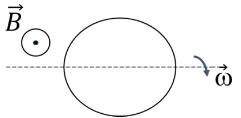
As in the figure, an infinitely long wire carries a current I = 1.0 A. It
is bent so as to have a semi-circular detour around the origin, with radius 1.0
cm. Calculate the magnetic field B at the origin.

Consider a parallel-plate capacitor with circular plates of radius R and
separation d << R.
The capacitor is being charged by a time-dependent current I(t) = I0
sin(ωt).
(a) Use Ampere's law to compute the displacement current density between the
plates as a function of radius r (for r < R).
(b) Find the magnetic field B(r, t) inside the capacitor (between
the plates).
(c) Discuss the behavior of B(r, t) for r > R, assuming the
current is confined within the radius R.
(a) Find the magnetic field at a distance s from the long straight
wire, carrying a steady current I.
(b) Find the flux of B through a square loop of wire (side a)
that lies on a table, a distance s from a very long straight wire with a current
I, as shown in the figure.

(c) If someone now pulls the loop directly away from the wire, at speed v,
what emf is generated? In what direction (clockwise or counterclockwise) does
the current flow?
A thin ring-shaped wire of mass M carries uniform electrical charge Q. The
wire rotates about its center axis with rotational velocity ω.
(a) What is the ratio of its magnetic dipole moment to its angular momentum?
(b) Classically, the electron is considered a spinning charged sphere.
According to quantum mechanics, the angular momentum of the spinning electron is
h/4π, with h the Planck constant. What torque acts on the electron at an angle
θ between the magnetic moment and an outer magnetic field B in terms of
the ratio derived in (a)? Explain how (a) applies.
(c) Derive the semi-classical precession angular velocity for an electron in
a 3 Tesla magnetic field.